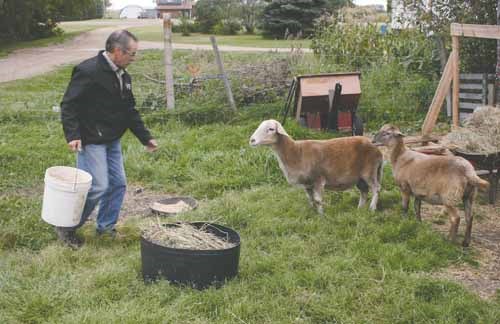Sheep have proven a perfect sideline for a Yorkton-area couple who both work in the city, but who wanted to do something on their quarter section of land west of the city.
"We got into it back in 2000. We had cattle prior to that, but with working out we just found cattle a little too much to do," explained Bernie Surkan.
Surkan said he and his wife began investigating alternatives.
"We sort of looked at some different things to do We wanted to do something with agriculture," he said, adding sheep, and in particular Katahdin sheep seemed like a perfect fit.
Surkan said they researched the breed and liked what they saw.
"We went on the Internet We phoned around and talked to people," he said.
So what was the draw of Katahdin over other breeds of sheep?
"They are a low maintenance animal," said Surkan.
The low maintenance is aided by the breed being a hair sheep, meaning they do not have wool which requires annual shearing, handling and marketing.
"You don't have to work with wool and the shearing," said Surkan, added in terms of a couple working off farm that was an important labour reducing aspect of Katahdin.
The development of the breed began in the late 1950's with the importation of a small number of wool-less sheep from the Caribbean by Michael Piel, of Maine, U.S.A.
By the time the Surkans became interested in Katahdins the breed was well-established, but still growing in numbers, meaning their first stock was costly.
"The first pair of bred ewes we got we spent about $1200," he said.
In terms of sheep it was a significant investment, one which turned out to be ill-timed, but still the start of their Twin Spruce Katahdins flock.
"Shortly after that BSE (bovine spongiform encephalopathy) hit the cattle sector," said Surkan, adding it also impacted other animals such as elk, bison, and sheep.
Returns on sheep slid rapidly lower.
"For feeder lambs we were getting 60, maybe 65 cents a pound," said Surkan.
The Surkans stuck with their new enterprise, and recently sheep have seen prices as strong as they have ever been.
"The last few years we've been doing very well with them," he said, noting lamb prices eclipsed $2 a pound for a time, a level he said in his mind was "a little too high."
This year prices have slipped back into the $1.20/$1.25 range for feeder lambs.
Surkan said the current prices can still mean a return provided ewes raise more than one lamb. With twins the first covers costs and the second is where a profit comes in.
"Katahdin ewes are very good at having twins," he said, adding triplets are not that rare "and we've had quads born on the farm."
In the time between the depressed prices caused by BSE, and the high prices of recent years, the Surkans made a move to diversify their marketing.
"We do quite a bit of farm-gating," he said, adding they like to get their whether lambs (castrated males) up to about 110 pounds, which will give them a 45-50 pound carcass.
Surkan said some take a whole, or half a lamb.
"They just enjoy eating lamb," he said.
But they also sell a lot of marinated lamb. Surkan said locally people will think of shishliki, but that is slightly different from what they offer.
Instead of cubing an entire lamb and putting it into a brine the Surkans use only lamb chops which they marinate and sell.
"That's been very, very popular," he said. "We've developed a fairly good base of clientele."
As for the marinate used, it's a recipe the Surkans developed themselves.
"We did a lot of taste testing until we came up with something we liked and the clientele like, so we've stuck with that," he said.
Surkan said in most cases they deliver to the city for customers.
"We bring it in just as a thank you," he said, adding it is a convenience too. "The customer doesn't have to leave his home."
Today the Surkans run a flock of 100 ewes, which fits nicely with their quarter section land base, with its 100-acres of hay, and the rest devoted to pasture and yard.
The flock is mostly purebred Katahdin ewes. The top females are bred back to a Katahdin ram to produce replacement females.
The rest of the flock are bred to Dorper rams.
Dorper are also hair-breed of sheep developed in South Africa which has been in Canada less than 25-years.
Surkan said the Dorper are a thicker, heavier breed which "grows a lot quicker than a Katahdin," so by using the Dorper rams "we basically get lambs to market a lot quicker."




